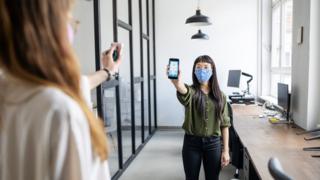Image copyright
Getty Images
The app can be downloaded free onto a mobile phone
More than 250,000 people have downloaded Scotland’s new contact tracing app since it went live.
It became available to download free onto a smart phone from Apple’s App Store or Google Play on Thursday.
The Protect Scotland app lets people know if they have been in close contact with someone who later tests positive.
The Scottish government has said the software will support the Test and Protect system and is “another tool in the fight against Covid-19”.
Up until now, contact tracing has been done manually using a method followed for years to help control the spread of infectious diseases.
- How to download Scotland’s contact tracing app
- Coronavirus in Scotland: Where are the latest cases?
First Minister Nicola Sturgeon has urged as many people as possible to get involved in the new tracing scheme.
Speaking in the Holyrood chamber on Thursday afternoon, she said: “The more people that sign up the better. Everybody who signs up is making a contribution.”
She told MSPs that the number of people who had downloaded the app had stood at 150,000 before she left her office to speak in parliament.
During First Minister’s Questions, she said the number had climbed to 200,000 since she had taken to her feet, which she described as “very positive”. It later emerged that the number had risen above 250,000.
Scotland has followed Northern Ireland in choosing to use the toolkit provided by Apple and Google to build a contact tracing app which has privacy built in. Both have moved quickly by using the software developed for Ireland’s app.
Scotland did at first seem inclined to work with the NHSX England app team, which for months pursued a centralised app collecting more data, without the co-operation of the tech giants.
But seeing some knotty technical issues with the English app they then decided to follow many other countries going down the Apple/Google route.
One person close to the Scottish project said “using something that the tech giants had created was easier than trying to create stuff ourselves”.
England also eventually changed tack and has been testing an app based on the Apple Google toolkit for the last month on the Isle of Wight and the London borough of Newham.
But there’s still no word on a national rollout – and it seems England, which once saw a contact tracing app as a vital weapon in the battle against the virus, is now happy to be a follower rather than a leader in this technology.
With 64,000 downloads by 09:00 on launch day, the Test and Protect team feel their app has got away to a good start – but the real question is whether it will help speed up warnings to people who may have been close to someone infected with the virus.
It will be weeks before we know whether the app is an effective tool.
Some iPhone users have reported not being able to download the app because they are not running iOS 13.
The iPhone 6 and older models launched before 2015 cannot run Apple’s latest operating system.
Android phone users will also need to be running at least the Android 6.0 operating system, which was launched in 2015, the Protect.scot website says.
Image copyright
Getty Images
Asked at First Minister’s Questions about people who did not use smartphones, Ms Sturgeon said the more people who used the app, the more effective it would be.
But the first minister told MSPs that the Scottish government had not based its entire test and protect system on a proximity tracing app.
“We’ve built it from the bottom up using tried and tested approaches in our public health teams and the app is an enhancement to that,” she said.
“So if you don’t have a phone, if you don’t use the app, you will not be missed from our test and protect system.”
Research by Ofcom from 2017 suggested that about 3.2m adults in Scotland owned a smartphone.
How does the app work?
The new app uses Bluetooth technology to alert users if they have been in prolonged close contact with someone who subsequently tests positive for Covid-19.
When an individual initially tests positive for the virus, they are contacted by phone in the usual way.
The contact tracer will ask them if they are an app user and if they are willing to use the app’s upload function to anonymously alert close contacts.
If they agree, they will be sent a unique code to their mobile which unlocks this function on the app.
By sharing their positive test result in this way, the information will form part of an anonymous database.
The app on other users’ phones regularly checks this database to see if they have been in contact with an infected person.
A warning is automatically issued when a match is found and users are then urged to get tested or self-isolate for 14 days.
